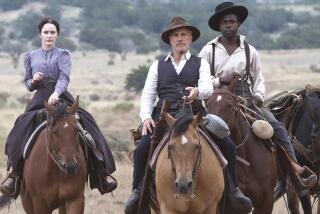He Made Gems Out of Peanuts
- Share via
Longtime movie director Budd Boetticher, who died last Friday of organ failure, was a cinephile’s director, famed throughout the world among movie buffs, little known by the general public.
A master of both low-budget westerns and film noirs, he created classics such as “The Bullfighter and the Lady” (1951), “The Tall T” (1957) and “The Rise and Fall of Legs Diamond” (1960). Boetticher, who was 85, was also one of the feistiest and most colorful directors ever; a tough, genial ex-professional bullfighter who fought hard and readily, alienated many studio executives and was known for blunt candor and a combative attitude.
A native Chicagoan, Boetticher was born July 29, 1916, son of the wealthy hardware concern owner Oscar Boetticher, for whom he was named (he changed to “Budd” in 1951). Boetticher attended Culver Military Academy (Indiana) and Ohio State University, where he was a varsity football and basketball player. But it was another sport that became his entree to Hollywood, when he traveled to Mexico after college, took up bullfighting and became one of the few American professional matadors.
Brought to 20th Century Fox as the bullfight advisor on the 1941 remake of “Blood and Sand,” Boetticher stayed there, gradually rising through the ranks to become one of the elite B movie and television directors (the early “Maverick”) of the ‘50s.
Boetticher’s most memorable work came in a brief, intensely prolific period between 1956 and 1960. He is most famous for the cycle of seven low-budget westerns he made in those years, all starring Randolph Scott. Along with “The Tall T,” this group includes Boetticher’s personal favorite, “Seven Men From Now” (1956), “Decision at Sundown” (1957), “Buchanan Rides Alone” (1958), “Ride Lonesome” (1959), “Westbound” (1959) and “Comanche Station” (1960).
All were taut, exciting films shot in about two weeks apiece, with lean, witty scripts (often by Burt Kennedy), stunning cinematography (sometimes by Boetticher’s close friend, Lucien Ballard) and remarkably intense relationships between the stalwart Scott and a series of colorful heavies played by actors such as Lee Marvin, James Coburn and Richard Boone.
Boetticher was equally skilled at crime and noir, as in 1956’s cop drama “The Killer Is Loose” and the stylish “Legs Diamond.” But it was, unsurprisingly, as a director of bullfight films that he had no peers. His 1951 “The Bullfighter and the Lady,” produced by John Ford, and starring Robert Stack as a Boetticher-like American matador, is a classic. So is his unusual documentary “Arruza” (1971), a look at Mexican bullfighter Carlos Arruza.
It was while filming “Arruza”--which stretched over most of the ‘60s, consumed much of Boetticher’s personal fortune and nearly cost him his life--that he became estranged from Hollywood, where he had been a reliable, if explosive, pro. After he returned, he made only one more fiction feature, the bizarrely cynical low-budget 1969 western “A Time for Dying.”
Then, he spent the rest of his life with wife Mary at their Ramona, Calif., ranch, where he wrote scripts and his memoirs, raised Andalusian horses and put on a yearly bloodless bullfighting exhibition.
*
Michael Wilmington is film critic for the Chicago Tribune, a Tribune Co. newspaper.
More to Read
Only good movies
Get the Indie Focus newsletter, Mark Olsen's weekly guide to the world of cinema.
You may occasionally receive promotional content from the Los Angeles Times.









